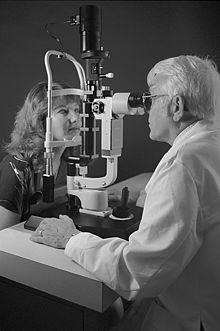Exploring the most recent Technical Innovations in Optometry and What They Mean for Eye Doctors
From the accuracy of Optical Coherence Tomography to the nuanced insights used by AI-driven analysis tools, these advancements are establishing brand-new standards in client analysis and therapy. As these advancements permeate the method, eye doctors are encountered with the obstacle of welcoming these tools to enhance client results.
Advancements in Diagnostic Devices
Progressing the field of optometry, developments in diagnostic tools have reinvented the means eye treatment specialists assess and diagnose ocular conditions and visual impairments. The past decade has experienced substantial technical advancements, enabling more accurate and comprehensive evaluations. Optical Coherence Tomography (OCT), as an example, offers high-resolution cross-sectional pictures of the retina, permitting the early detection of conditions such as glaucoma and age-related macular deterioration. This non-invasive imaging technique has become essential in modern optometric method.
One more trick development is the intro of advanced corneal topography systems, which map the surface area curvature of the cornea with precision. These tools are specifically beneficial for fitting call lenses and identifying corneal problems. Digital retinal imaging has actually changed traditional ophthalmoscopy, offering comprehensive, panoramic sights of the retina that assist in thorough aesthetic exams.
The development of wavefront aberrometry has also been crucial, enabling the evaluation of refractive errors with unparalleled precision (Eye Doctor). This modern technology aids in personalizing rehabilitative lenses and enhancing medical results for refractive surgical treatments. Collectively, these analysis innovations encourage optometrists to supply remarkable person treatment, making certain early intervention and customized therapy approaches, inevitably boosting aesthetic health and wellness results
AI in Patient Management
Structure on the foundation of sophisticated diagnostic devices, the consolidation of artificial knowledge (AI) in patient administration stands for a transformative leap for optometry. AI systems are significantly utilized to boost effectiveness, precision, and personalization in individual care.
Additionally, AI-driven platforms assist in structured client communications and management processes. Automated organizing, digital examinations, and individualized follow-up strategies not just enhance person satisfaction but also maximize time administration for experts. These systems can triage patients based on the necessity of their problems, making certain that those in vital demand receive punctual focus.
Additionally, AI improves decision-making by providing eye doctors with evidence-based recommendations and treatment paths. By integrating information from digital health records, AI devices supply understandings that educate medical decisions, minimizing the threat of mistakes and boosting patient outcomes. As AI remains to develop, its duty in person monitoring will likely expand, reshaping the landscape of optometric care.
Developments in Retinal Imaging
In the world of optometry, retinal imaging has witnessed impressive technical advancements that are improving diagnostic capabilities and client treatment. Developments such as Optical Coherence Tomography (OCT) and fundus digital photography have transformed how eye doctors examine the retina and imagine.
Enhanced imaging methods like OCT angiography are additional refining diagnostic precision. Eye Doctor. Such improvements promote the identification of min retinal modifications that can signify disease development.
Additionally, advancements in expert system are increasing retinal imaging by allowing computerized evaluation of big datasets. These systems aid eye doctors in identifying patterns a sign of pathology, consequently boosting analysis precision and performance. Collectively, these developments are changing retinal imaging right into a keystone of modern eye treatment, enhancing end results and increasing restorative possibilities.
Teleoptometry's Expanding Duty
Teleoptometry is progressively coming to be an important element of eye treatment, driven by improvements in digital interaction and diagnostic devices. This is particularly useful in underserved and rural locations where accessibility to specialized eye treatment is often restricted.
The combination of expert system (AI) additional enhances teleoptometry, enabling the evaluation of aesthetic data and helping in the detection of ocular problems such as glaucoma and diabetic retinopathy. AI-powered formulas can rapidly analyze complicated imaging data, giving eye doctors with useful insights that boost medical decision-making.
In addition, teleoptometry supports continuity of treatment through smooth integration with digital health documents (EHRs), allowing optometrists to keep extensive individual backgrounds. When consulting with various experts., this guarantees that individuals obtain consistent and individualized care even.
In spite of these benefits, obstacles remain, including making sure information security and handling individual assumptions. Teleoptometry stands for a considerable stride towards even more accessible, reliable, and patient-centered eye treatment. As technology evolves, its duty is positioned to expand further.

Future Fads in Eye Treatment
A myriad of cutting-edge patterns is readied to improve the future of eye treatment, driven by technical advancements and the advancing requirements of people. One significant trend is the combination of fabricated knowledge (AI) in diagnostics, which promises to boost the accuracy and efficiency of eye examinations. AI algorithms can analyze huge amounts of information from retinal images, potentially identifying conditions like diabetic person retinopathy and glaucoma earlier than standard techniques.
Furthermore, personalized medicine is getting grip in optometry, with hereditary testing notifying customized treatment plans. This strategy aims to enhance client end results by customizing interventions to private genetic accounts. Wearable modern technology, such as smart call lenses, is also coming up, supplying real-time surveillance click now of intraocular pressure or sugar levels, therefore supplying constant understandings right into systemic and eye health.
The fostering of increased truth (AR) and online truth (VR) navigate here in training and individual education and learning is another arising pattern. These innovations provide immersive experiences that can enhance understanding and skills both for clients and optometrists. As these trends progress, eye doctors must stay abreast of technological advancements to offer innovative treatment, ensuring better individual end results and satisfaction in the dynamic landscape of eye treatment.
Final Thought

Jointly, these analysis advancements encourage optometrists to deliver superior individual treatment, ensuring very early intervention and customized treatment techniques, eventually improving visual health and wellness results.

As these innovations proceed to develop, eye doctors have to adjust and incorporate them into technique, ultimately optimizing process performance and elevating the standard of eye care delivered to individuals.